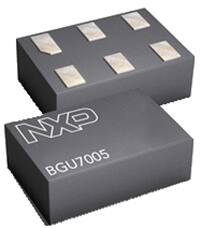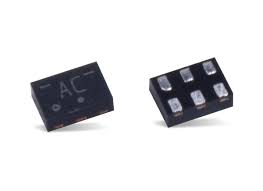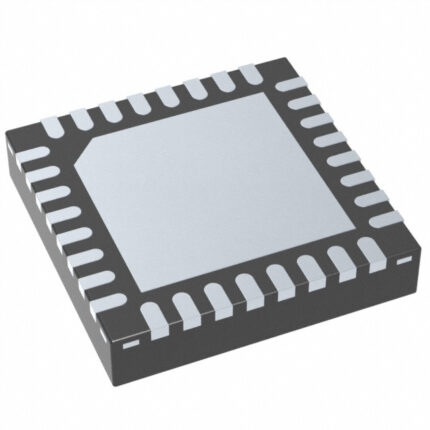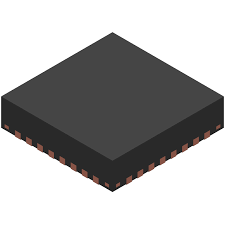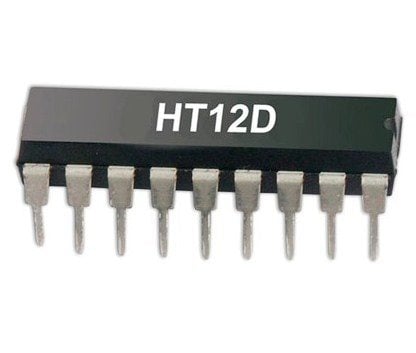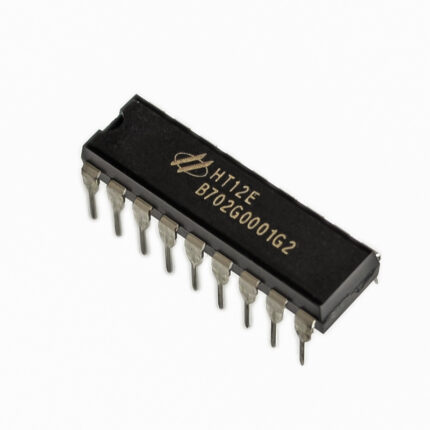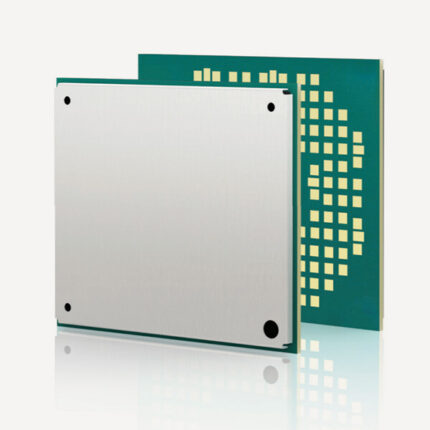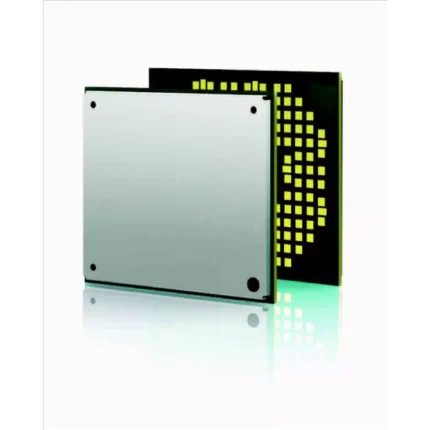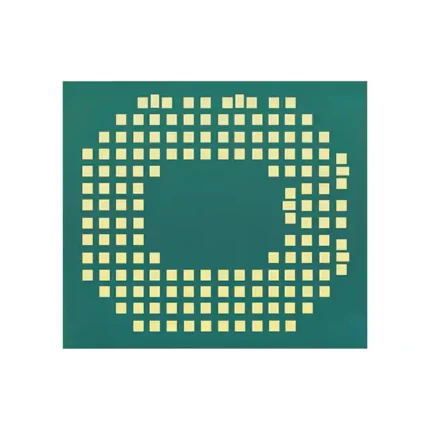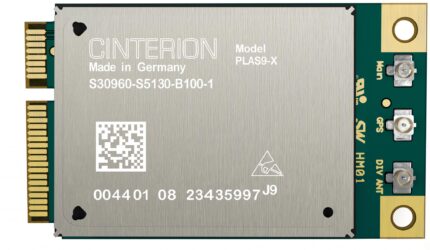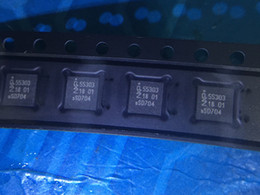BGU7005
Benefits and features of BGU7005
- Covers the entire GNSS L1 range, 1559 to 1610 MHz
- Noise figure (NF) is equal to 0.85 dB.
- Increase 16.5 dB
- A lot of input Pi(1dB), or 1 dB compression point, is 11 dBm.
- High IP3i out of band of 9 dBm
- 1.5 to 3.1 volts is the supply voltage.
- Consumption of current in power-saving mode is 1 A.
- Optimized performance at 4.5 mA, a low supply current
- Output matching that is integrated
- Only needs one supply decoupling capacitor and one input matching inductor.
- Decoupled DC input and output
- All pins have ESD protection (HBM > 2 kV).
- Temperature-stabilized bias included for simple design
- Small leadless 6-pin package 1.45 mm, 1 mm, and 0.5 mm
- Transit frequency of 110 GHz using SiGe:C technology
CC2592RGV
Features of CC2592
- LNA Gain Digitally Controlled via an HGM Terminal
- (LNA EN = PA EN = 0) 100 nA in Power Down
- Little Transmit Current Use -PAE = 34% at -155 mA at 3 V for +22 dBm
- Low Receiving Current Intake -For High-Gain Mode, use -4.0 mA -For Low-Gain Mode, -1.9 mA
- T/R Switch and External Antenna Match Included in the 4.7-dB LNA Noise Figure
- Conforms to RoHS QFN-16 Package, 4-mm by 4-mm
- Operation from 2.0-V to 3.7-V
- Operating Range: -40?C to +125?C
- Texas Instruments' Seamless Interface to 2.4-GHz Low-Power RF Devices
- Power Output: +22 dBm
- Improved Sensitivity of 3 dB Typically on CC2520, CC253X, and CC85XX
- Almost No External Components -Switches that are built-in -Network for Integrated Matching -Balun integrated -Integral Inductors -Integration of PA -LNA integrated
- Every 2.4-GHz ISM Band Device
- Gateways for ZigBee and IEEE 802.15.4
- Sensor Networks, Wireless
- Consumer Wireless Systems
- Industrial Wireless Systems
- Systems for Wireless Audio
- Metering systems utilizing IEEE 802.15.4 and ZigBee?
CC2640F128RSM
Application of CC2640F128RSM
- Building and Home Automation-Appliances That Are Connected -Lights -Locks -The Gateways -Systems for Security
- Industrial- Supply chain - Manufacturing and Production - Robotics - Asset Management and Tracking - Wireless Display - Replacement of cables ? HMI - Access Management
- Retail-The beacons - Promotion - Price Tags and ESL - Payment and Point of Sale Systems
- Medical and Health-Temperature gauges - SpO2 - Blood pressure and glucose metres - Weighbridges - Vitals Tracking - Aids to hearing
- Exercise and Sports-Fitness trackers and activity monitors -Monitors for Heart Rate -Operating Sensors -Bicycle Sensors -Watches for sports - Fitness Gear - Gear for team sports
- Accessories-Toys -Followers -Tags for bags -Smartwatches
- Microcontroller-Strong ARM? Cortex? -M3 - 142 for EEMBC CoreMark? - Maximum Clock Speed of 48 MHz - 128 KB of programmable in-system flash - Cache: 8KB of SRAM - 20KB of SRAM with ultra-low leakage. - JTAG and 2-Pin cJTAG Debugging - Facilitates Over-The-Air Upgrade (OTA)
- Sensor Controller with Ultralow Power- Can Operate Independently of the Rest of the System -16-Bit architecture - 2KB of SRAM with extremely minimal leakage for code and data.
- Peripherals- Any GPIO Can Be Used to Route All Digital Peripheral Pins - Four modules for general-purpose timers. - 200 ksamples/s, 8-Channel Analog MUX, 12-Bit ADC - Comparator for Continuous Time - Ultralow-Power Analog Comparer -Modifiable Current Source - Clock in Real Time (RTC) - Security Module AES-128 -The TRNG (True Random Number Generator) (TRNG) - Depending on the package option, 10, 15, or 31 GPIOs - Eight capacitive-sensing buttons are supported. - Temperature sensor built-in
CC2650F128RHB
Features of CC2650F128RHB
- Microprocessor - Strong ARM Cortex-M3 processor - 142 for EEMBC CoreMark? - Maximum Clock Speed of 48 MHz - 128 KB of programmable in-system flash - Cache: 8KB of SRAM - 20KB of SRAM with ultra-low leakage. - JTAG and 2-Pin cJTAG Debugging - Facilitates Over-The-Air Upgrade (OTA)
- Sensor Controller with Ultralow Power - Can Operate Independently of the Rest of the System - 16-Bit architecture - 2KB of SRAM with extremely minimal leakage for code and data.
- Packages Compliant with RoHS - RSM VQFN32, 4-mm x?4-mm (10 GPIOs) - RHB VQFN32, 5-mm x?5-mm (15 GPIOs) - RGZ VQFN48, 7-mm x?7-mm (31 GPIOs)
- Peripherals - Any GPIO Can Be Used to Route All Digital Peripheral Pins - Four modules for general-purpose timers. - 200 ksamples/s, 8-Channel Analog MUX, 12-Bit ADC - Comparator for Continuous Time - Ultralow-Power Analog Comparer -Modifiable Current Source - UART - Clock in Real Time (RTC) - Security Module AES-128 - The TRNG (True Random Number Generator) (TRNG) - Depending on the package option, 10, 15, or 31 GPIOs - Eight capacitive-sensing buttons are supported. - Temperature sensor built-in
- ?Outside System - Internal On-Chip DC-DC Converter - Low Number of External Components - Complete Integration With Simple LinkTM CC2590 and CC2592 Range Extenders - Compatible with the CC13xx pin of Simple Link - VQFN Packages in 4-mm x 4-mm and 5-mm x 5-mm sizes
- Small Power - Broad Supply Voltage Spectrum ? In normal use, 1.8 to 3.8 V ? 1.7 to 1.95 V in external regulator mode -5.9 mA Active-Mode RX - Active-Mode TX: 6.1 mA at 0 dBm - 9.1 mA for Active-Mode TX at +5 dBm -MCU in Active Mode: 61 A/MHz -48.5 CoreMark/mA for Active-Mode MCU -8.2 A/MHz Active-Mode Sensor Controller - RAM/CPU Retention and RTC Running: 1 A in Standby - Shutdown 100 nanoamperes (Wake Up on External Events)
- Electronics for consumers
- Cellular Phone Accessory
- Sports and exercise gear
- Applications for HID
- Building and Home Automation
- Lighting Management
- Security and Alarm
- Labeling Electronic Shelves
- Nearby tags
- Health
- Wireless controls
- Sensor Networks, Wireless
HT12D Decoder IC
HT12D is a decoder integrated circuit that belongs to 212 series of decoders. This series of decoders are mainly used for remote control system applications, like burglar alarm, car door controller, security system etc. It is mainly provided to interface RF and infrared circuits.? They are paired with 212 series of encoders. The chosen pair of encoder/decoder should have same number of addresses and data format.In simple terms, HT12D converts the serial input into parallel outputs. It decodes the serial addresses and data received by, say, an RF receiver, into parallel data and sends them to output data pins. The serial input data is compared with the local addresses three times continuously. The input data code is decoded when no error or unmatched codes are found. A valid transmission in indicated by a high signal at VT pin. HT12D is capable of decoding 12 bits, of which 8 are address bits and 4 are data bits. The data on 4 bit latch type output pins remain unchanged until new is received.
Datasheet of ht12d decoder ic
HT12E Encoder IC
HT12E is an encoder integrated circuit of 212 series of encoders. They are paired with 212 series of decoders for use in remote control system applications. It is mainly used in interfacing RF and infrared circuits. The chosen pair of encoder/decoder should have same number of addresses and data format.
Simply put, HT12E converts the parallel inputs into serial output. It encodes the 12 bit parallel data into serial for transmission through an RF transmitter. These 12 bits are divided into 8 address bits and 4 data bits. HT12E has a transmission enable pin which is active low. When a trigger signal is received on TE pin, the programmed addresses/data are transmitted together with the header bits via an RF or an infrared transmission medium. HT12E begins a 4-word transmission cycle upon receipt of a transmission enable. This cycle is repeated as long as TE is kept low. As soon as TE returns to high, the encoder output completes its final cycle and then stops.
L30960-N3400-A400
Features of L30960-N3400-A400
- LTE (20,8,3,7,1); 3G (8,3); and 2G Dual Band PLS8-E
- PLS8-US: 3G (5,4,2), 2G Quad Band, and LTE (17,5,4,2).
- LTE (1,3,19); 3G; PLS8-J (1,19)
- PLS8-X: 3G (5,4,2), 2G Quad Band, and LTE (13,17,5,4,2).
- LTE PLS8-V: (13,4,2)
- LTE (2x2 DL-MIMO; FDD 3GPP Release 9)
- 3GPP Release 8; UMTS/HSPA (FDD); Rx diversity
- 3GPP Release 6; DARP/SAIC; GSM/GPRS/EDGE
- SIM Application Toolkit, version 99 of the 3GPP
- Using AT instructions to control (Hayes, TS 27.007, TS 27.005)
- Complete GPS/GLONASS integration (Qualcomm gpsOne Gen8A)
- 3.3 to 4.2 V supply voltage range, especially tuned for low power usage
- Dimensions are 29 mm by 33 mm by 2,2 mm (PLS8-V/-X: H=2,9 mm).
- Range of Operation: -40 ?C to +85 ?C
- EuP support, RoHS and REACH compliance
- Multiple composite modes and a Linux/Mac-compliant mode are supported by the USB interface.
- USB-based firmware update
- BIP (Bearer Independent Protocol) (Bearer Independent Protocol)
- From Rel.3.0 and for PLS8-X /-V, IP services (Client & Server, TCP/IP & UDP, Transparent & Nontransparent) are available.
- According to 3GPP TS 27.010, a multiplexer
- Carrier Switching Automatic (PLS8-X)
L30960-N3410-A400
Features of L30960-N3410-A400
- LTE (20,8,3,7,1); 3G (8,3); and 2G Dual Band PLS8-E
- PLS8-US: 3G (5,4,2), 2G Quad Band, and LTE (17,5,4,2).
- LTE (1,3,19); 3G; PLS8-J (1,19)
- PLS8-X: 3G (5,4,2), 2G Quad Band, and LTE (13,17,5,4,2).
- LTE PLS8-V: (13,4,2)
- LTE (2x2 DL-MIMO; FDD 3GPP Release 9)
- 3GPP Release 8; UMTS/HSPA (FDD); Rx diversity
- 3GPP Release 6; DARP/SAIC; GSM/GPRS/EDGE
- SIM Application Toolkit, version 99 of the 3GPP
- Using AT instructions to control (Hayes, TS 27.007, TS 27.005)
- Complete GPS/GLONASS integration (Qualcomm gpsOne Gen8A)
- 3.3 to 4.2 V supply voltage range, especially tuned for low power usage
- Dimensions are 29 mm by 33 mm by 2,2 mm (PLS8-V/-X: H=2,9 mm).
- Range of Operation: -40 ?C to +85 ?C
- EuP support, RoHS and REACH compliance
- Multiple composite modes and a Linux/Mac-compliant mode are supported by the USB interface.
- USB-based firmware update
- BIP (Bearer Independent Protocol) (Bearer Independent Protocol)
- From Rel.3.0 and for PLS8-X /-V, IP services (Client & Server, TCP/IP & UDP, Transparent & Nontransparent) are available.
- According to 3GPP TS 27.010, a multiplexer
- PLS8-X Automatic Carrier Switching
L30960-N5130-B100
Features? of? L30960-N5130-B100
- LTE (2x2 DL-MIMO; FDD 3GPP Release 9)
- 3GPP Release 8; UMTS/HSPA (FDD); Rx diversity
- 3GPP Release 6; DARP/SAIC; GSM/GPRS/EDGE
- SIM Application Toolkit, version 99 of the 3GPP
- Using AT instructions to control (Hayes, TS 27.007, TS 27.005)
- 3.3 to 4.2 V supply voltage range, especially tuned for low power usage
- Size: 40, 32, and 2,8 mm
- Range of Operation Temperature: -40 ?C to +95 ?
- Compliant with RoHS, RED, and REACH, EuP assistance
- The USB 2.0/3.0 interface provides several composite modes and a mode that is compatible with Linux and Mac.
- USB-based firmware update
MT8870 IC – DTMF Decoder IC
The MT8870 is a complete DTMF receiver integrating both the bandsplit filter and digital decoder functions. The filter section uses switched capacitor techniques for high and low group filters; the decoder uses digital counting techniques to detect and decode all 16 DTMF tone-pairs into a 4-bit code.
MT8880 IC – DTMF Encoder IC
The MT8880 is a monolithic DTMF transceiver with call progress filter. It is fabricated in Mitel?s ISO2- CMOS technology, which provides low power dissipation and high reliability. The DTMF receiver is based upon the industry standard MT8870 monolithic DTMF receiver; the transmitter utilizes a switched capacitor D/A converter for low distortion, high accuracy DTMF signalling. Internal counters provide a burst mode such that tone bursts can be transmitted with precise timing. A call progress filter can be selected allowing a microprocessor to analyze call progress tones. A standard microprocessor bus is provided and is directly compatible with 6800 series microprocessors.
